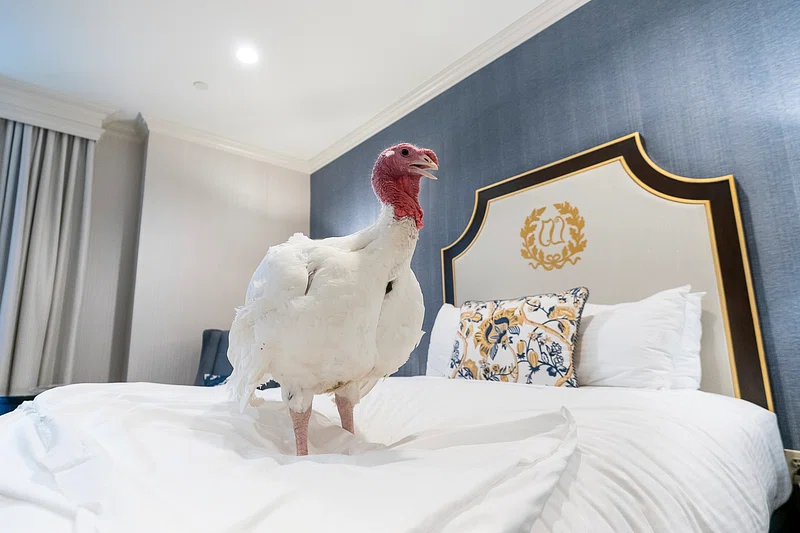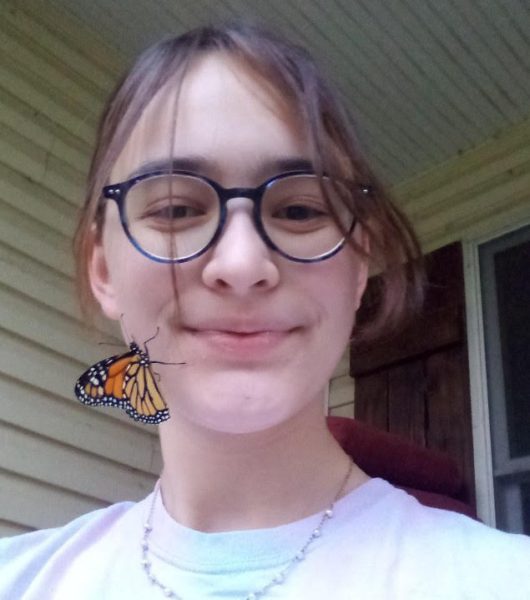![A female monarch raised by the author, hanging out with her for a while. [July 2024]](https://lakevillesouthnews.com/wp-content/uploads/2024/09/IMG_0569.jpeg)
Have you ever seen a large, orange-and-black butterfly with spots of white fluttering around your yard or school? Chances are that was a monarch butterfly. Monarchs are found on every continent except Antarctica, and they are one of the most well-known butterflies on earth. These fluttering pollinators intrigue families and delight young children. But there are dangers lurking that constantly threaten the existence of these beloved butterflies daily.
- Predators. Monarchs, despite the toxins stored in their bodies from the milkweed they eat, do have predators: invertebrates are not affected by the cardiac glycosides in milkweed sap. Therefore, insects such as ants, spiders, parasitic flies, and parasitic/non-parasitic wasps prey on monarchs in all life stages.
- Pesticides and herbicides. Many farmers and homeowners consider milkweed, which can spread fairly quickly, an undesirable weed and so spray them with herbicides and/or pull them. Additionally, many people spray plants with pesticide, which affects bees, caterpillars, and butterflies and moths too.
- Illness and disease. Maladies like nuclear polyhedrosis virus (NPV) and bacterial infections can quickly kill a monarch. Ophryocystis elektroscirrha, or OE, is a parasitic spore that has developed for thousands of years to live alongside monarchs, and lives on milkweeds, infecting milkweed-eating butterflies including the queen and monarch.
- Habitat destruction. When people kill milkweeds, they are depriving the monarch caterpillar of its only food source. A lot of butterfly caterpillars can eat multiple plants, such as eastern tiger swallowtails feeding on bay magnolia, wild cherry, and lilac. However, monarchs only eat milkweeds, which means that they are limited to one type of plant and are in especial trouble if all the milkweeds in an area are eradicated suddenly.
Monarchs are fascinating creatures; they go through a cycle called “complete metamorphosis”, meaning that an insect cycles through four stages of life: egg, larva, pupa and adult, adult being its last stage of life. A monarch emerges from its egg three or four days after its egg is laid on a milkweed leaf. It then spends roughly two weeks as a caterpillar (larva), increasing in size by up to 2,000%. The next two weeks of its life are spent in its pupa form – the chrysalis – which it begins by hanging upside down from a self-spun silken pad in the shape of a J. After about a day, the monarch sheds its final caterpillar skin, revealing the skin beneath, which hardens to become its chrysalis. Finally, the monarch ecloses (hatches) as a butterfly. (And no – no butterfly turns into liquid in the chrysalis and reforms as a butterfly! If a butterfly turns to liquid in the chrysalis, that’s because it has died of a disease.)
The monarch population is constantly in flux. Changes in population send the status of the monarch butterfly bouncing from threatened to endangered back to threatened again. From year to year, there always seems to be dire news in some form. Organizations like Monarch Watch, based out of the University of Kansas, record and track trends of the American monarch population such as OE infections and migration size. Monarch Watch believes this year’s migration will be late in many states this autumn due to the cold front that arrived in several northern breeding areas in early August, causing developmental delays and pushing emergence back by roughly ten days at the minimum. Luckily, there are things you can do to assist the monarch population next summer and in summers to come!
- Plant milkweed in your yard/garden. If you have a place in your yard to scatter some milkweed seeds or plant milkweed seedlings, this is an excellent way to provide monarch butterflies with an accommodating place to lay eggs and their caterpillars with a place to grow! If you buy plants from a greenhouse or nursery, be sure to check with staff and make sure the plants are not treated with pesticides or other chemicals before purchasing. These chemicals will quickly kill any caterpillars who find their way to these plants in the future.
- Plant native flowers and host plants in your yard/garden. Got some more extra, empty space? Butterfly weed, coneflowers, clematis, milkweed, meadow blazingstar, and beebalm are all examples of flowers different species of butterfly like to nectar from. Bees and butterflies cover the milkweeds and coneflowers in our yard all year, and my mother’s clematises attract tiny red admiral butterflies in the summertime. And host plants, or the plants butterfly caterpillars feed on, are a huge attractor; you can try planting wild lupine to attract endangered karner blues; lilac bushes to attract tiger swallowtails; Queen Anne’s lace, parsley or dill to attract black swallowtails; or violets to attract great spangled fritillaries to your garden.
- Stop spraying. Lots of people spray weeds in their yards . . . and milkweed and other important butterfly host plants, such as thistle, often get caught up in the spray. This is detrimental to butterfly populations, and so are insecticides and any chemical in general. Next time you notice persistent weeds in your yard or gardens, pull the ragweed, pigweed, dandelions and annoying grasses and leave the milkweed standing!
As pollinators, monarch butterflies are very important to nature, and even to human agriculture! Bees and butterflies pollinate fruit trees, flowers, and other plants to keep ecosystems thriving. Will you help to keep the monarch butterfly from extinction?
Sources:
– https://www.kglandscape.com/pollinator-plants (native pollinator plants)
– https://monarchbutterflylifecycle.com/blogs/raise/monarch-diseases-parasites-prevention?srsltid=AfmBOopmWxGsj4V8xuQL178LGnPbk7a4beQS064FMN9s-iwpwng01MJx (monarch diseases, parasites, & other killers)
– https://monarchwatch.org/blog/ (migration of 2024)
*Much of the information in this article comes from the author’s research done on and hands-on experience with monarch butterflies since 2018.*


